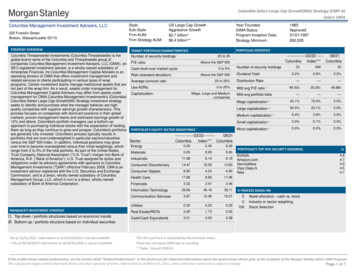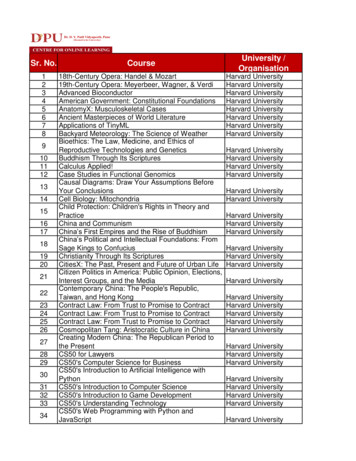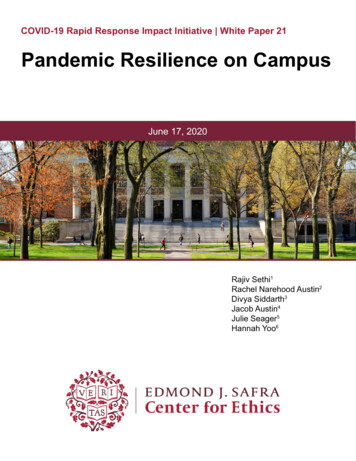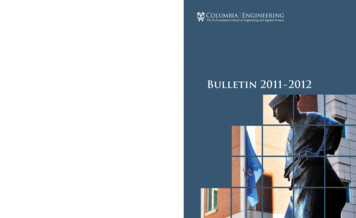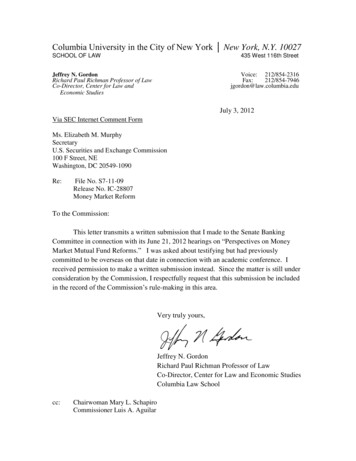
Transcription
Columbia University in the City of New York New York, N.Y. 10027SCHOOL OF LAW435 West 116th StreetVoice: duJeffrey N. GordonRichard Paul Richman Professor of LawCo-Director, Center for Law andEconomic StudiesJuly 3, 2012Via SEC Internet Comment FormMs. Elizabeth M. MurphySecretaryU.S. Securities and Exchange Commission100 F Street, NEWashington, DC 20549-1090Re:File No. S7-11-09Release No. IC-28807Money Market ReformTo the Commission:This letter transmits a written submission that I made to the Senate BankingCommittee in connection with its June 21, 2012 hearings on “Perspectives on MoneyMarket Mutual Fund Reforms.” I was asked about testifying but had previouslycommitted to be overseas on that date in connection with an academic conference. Ireceived permission to make a written submission instead. Since the matter is still underconsideration by the Commission, I respectfully request that this submission be includedin the record of the Commission’s rule-making in this area.Very truly yours,Jeffrey N. GordonRichard Paul Richman Professor of LawCo-Director, Center for Law and Economic StudiesColumbia Law Schoolcc:Chairwoman Mary L. SchapiroCommissioner Luis A. Aguilar
Commissioner Daniel M. GallagherCommissioner Troy A. ParedesCommissioner Elisse B. WalterDivision of Investment Management Director Eileen RomingerDivision of Investment Management Associate Director Robert E. Plaze2
Submission by Jeffrey N. GordonRichard Paul Richman Professor of Law and Co-Director, Center for Law andEconomic Studies, Columbia Law SchoolPerspectives on Money Market Mutual Fund ReformBefore the Committee on Banking, Housing, and Urban Affairs, U.S. SenateJune 21, 2012Chairman Johnson, Ranking Member Shelby, and other members of theCommittee, thank you for the opportunity to address the topic of money market fundreform through this written submission. I have studied the money market fund problemsince the fall of 2008. This has resulted in two detailed comment letters to the SEC, onein September 2009 and the other in August 2011, both of which are attached to thissubmission. A co-author and I have also conducted empirical analysis of the relative runrisks of floating vs. fixed net asset value (“NAV”) funds, based on a “natural experiment”involving off-shore dollar-denominated money market funds during “Lehman week” inSeptember 2008. These self-regulated funds generally follow the SEC rules on portfoliocomposition but are available in both fixed and floating NAV. We find that thefixed/floating distinction does not explain the variation in the run rate across funds; rather,the relative risk of the fund, proxied by yield prior to Lehman week, is the crucial fundlevel explanatory variable. (We are in the process of finishing a draft of this research,which should be public shortly.)For the record, none of my research in this area has been supported by any partyother than Columbia Law School as part of the customary research funding it provides tofaculty members.Based on this cumulative work, my views are the following: Money Market Mutual Funds (“MMFs”) are like banks, except they have noprovision for bearing loss and internalize none of the systemic risk costs of theiractivities. MMFs present a unique “two-sided” run problem that makes them an unstablesource of credit. Since most MMF credit is now extended to banks, this makesMMFs a significant vector for financial crisis. These problems can be addressed through requiring MMF investors to acquirebundles of Class A/Class B shares, in which fixed NAV is preserved for the ClassA shares.1
To elaborate on these views:First, a money market mutual fund is like a bank in that it holds a portfolio ofrisky assets (non-U.S. Treasury), yet, unlike a bank, holds no capital nor any other firstloss protection. Its NAV will fall below 1 upon the default of virtually any appreciableportfolio holding, unless the sponsor decides to step in to cover the loss. The fact thatsponsors frequently have provided such suppport provides no assurance that a particularsponsor(s) will have sufficient resources or willingness to provide support in the midst ofa financial crisis.The Reserve Primary Fund illustrates the problem of sponsor incapacity for alarge fund, and at only 60 billion, this fund was hardly the largest. Moreover, it issimply false that sponsors provided sufficient support to protect their MMFs duringSeptember 2008. The entire industry received massive federal support that consisted notonly of the well-known Treasury guarantee (for which a fee was paid) but also a FederalReserve guarantee of the most problematic MMF assets, for which no fee was paid. Thisguarantee took place through the terms on which the Fed offered to extend credit throughits “Asset-Backed Commercial Paper MMF Liquidity Facility”: lend to MMFs (throughback-to-back bank loans) at par on a non-recourse basis to finance the weakest assets inthe MMF portfolio. Approximately 150 billion was drawn down on this facility in thefirst 10 days following the Reserve Primary Fund default. Nine of the ten largest MMFs,representing two-thirds of all MMF assets, used the AMLF. Only Vanguard did not usethe emergency credit facility. 1Second, the lack of capital or any other first-loss protection means that MMFs areexposed to a “two-sided run problem.” One side of the run problem is well understood:MMF fund investors who perceive a risk of default will want to be first in line at thewithdrawal window. If other investors perceive a similar risk, the best strategy is towithdraw first and ask questions later, producing a run. The second side of the runproblem is less well-understood but equally important. MMFs provide short term financeto financial institutions (especially banks) as well as to non-financial commerical paperusers. Precisely because they have no first loss protection against default of portfoliosecurities, MMFs will be extremely sensitive to the risk of default by the parties theyfinance. This means, for example, if a bank runs into financial distress, MMFs will eithershorten the maturity of the obligations from this counterparty or refuse to rollover theobligations altogether. In other words, because of the first run problem, the MMFdepositor run risk, MMFs in turn create a run problem for parties that depend on MMFfinancing. Because of the threat that depositors will run on the MMFs, the MMFs mayrun on their counterparties.Third, the two-sided run problem has very important (negative) macroimplications. A little background is necessary. The main function of MMFs currently isto provide diversified portfolios of credit-screened short-term claims on financial firms to1See Ben Levisohn & Daisy Maxey, Absent Help, More Funds Might Have Broken Buck, Wall St. JOnline, Dec. 1, 2010.2
cash-holding institutions seeking safety and liquidity. For example, an operatingcompany with large cash reserves could deposit the funds in a bank or itself assemble aportfolio of money market instruments. An MMF is better than these two alternatives,because a diversified portfolio of financial firm claims is safer than a deposit in a singlebank (given the cap on deposit insurance), and the MMF can achieve scale economies inproducing divesified, screened portfolios of such claims. In the evolution of MMFs fromthe 1980s until the present, the largest users have become institutional, and the mix ofMMF assets has moved overwhelmingly to claims on financial firms (and relatedfinancing entities). Such financial sector claims constitute an estimated 80 percent of allnon-U.S. government assets held by prime MMFs. Although it is true that MMFs are thedominant source of commercial paper issued by non-financial firms, such CP issuanceshave become an increasingly unimportant part of the MMF balance sheet.Two implications follow. First, MMFs have become a major vector for financialsector distress. Because the credit-worthiness of financial firms is highly correlated, if asingle financial firm defaults on its money market issuances, MMFs will take this as asignal of the likelihood of other defaults in the financial sector and will thus run on manyother financial firms by refusing to roll over credit. This will provoke an immediatefunding crisis throughout the financial sector. Second, even without an outright default,as the threat of financial distress looms, MMFs will restrict the terms on which theyextend credit, for example, shortening maturities and refusing to rollover credit forcertain financial firms. The knock-on effects are significant: Responding to their MMFfunders, banks will behave accordingly in their own credit extensions, to avoid a liquidityshortfall. Loans will not be made; maturities will shorten. Recent press accounts, whichdescribe the shortening of MMF credit extensions to banks and the MMFs’ withdrawalfrom lending to European banks alongside the corresponding contraction in bank assets,show that this effect is not hypothetical. A constriction of credit is obviously a negativefor economic growth.Here is the policy-relevant structural point: A significant fraction of thisparticular vicious circle is the direct result of the fragility of the MMFs themselves aspresently designed. To repeat: The MMFs have no capacity to bear default on anyportfolio security. Thus, much of the wholesale short term funding mechanism dances tothe MMFs’ short-rigged tune.Fourth, it is possible to design an MMF that will preserve the benefits currentlyassociated with MMFs but reduces some of the systemic risk and other negative effects.My August 2011 comment letter extensively presents such a proposal. The main featureis this: Institutions that invest in MMFs buy two classes of MMF stock, Class A andClass B, as a Class A/Class B bundle, in a ratio of roughly 95% to 5%.2, 3 Class A sharescarry fixed NAV and thus can be used transactionally without tax or accountingconsequences; Class B may float in value and may bear loss. An investor can withdrawClass A shares at will. Class B shares can be withdrawn only upon a 7-day (or 30-day)lag, a holdback.23I treat retail funds differently, but they could be handled the same way.I pick 5% because that is the largest allowable portfolio position for a single issuer under Rule 2a-7.3
The proceeds of Class A and Class B shares will be invested identically by theMMF. In ordinary times, the investors face no costs, except some loss of liquidity on the5%. But the Class B shares do bear the risk of loss in a default of a portfolio security thatis not covered by a sponsor, or losses occurring in a fire sale of assets to raise cash forredemptions. Other details are spelled out in the comment letter.There are three advantages. First, this arrangment significantly enhances MMFstability, which will reduce not only their systemic risk potential but will also changeMMF behavior in periods of financial stress, like right now. Because MMFs will havefirst loss protection, their own funding decisions need not be on hair trigger, with positiveeffects throughout the short term funding process. This may encourage bank extensionsof credit to non-financial borrowers.Second, the structure of the Class A/Class B bundle protects not only againstportfolio defaults but also against run risk. That is because a Class A holder also ownsClass B. Class A holders will therefore be far less likely to run, because a run that leadsthe MMF to sell assets at fire-sale values and thus to break the buck will be costly for theholder’s Class B shares. Before a run was “free” to the holder; now there will bepotential costs.Third, the cost of this arrangement is borne by the MMF users, not the sponsors orthe taxpayers. This proposal will not drive the MMF industry out of business. The fact is,institutional MMF investors have no better alternative. Short term bond funds, of course,have floating NAV. Bank deposits carry risk if uninsured. This proposal merely requiresinstitutional MMF investors to internalize the cost of systemic stability for MMFs ratherthan relying on implicit guarantees from the rest of the financial sector and the U.S.government (and the taxpayers).Thank you very much for your attention.###4
Columbia University in the City of New York New York, N.Y. 10027SCHOOL OF LAWJeffrey N. GordonRichard Paul Richman Professor of LawCo-Director, Center for Law andEconomic Studies435 West 116th StreetVoice: duAugust 12, 2011Via SEC Internet Comment FormMs. Elizabeth M. MurphySecretaryU.S. Securities and Exchange Commission100 F Street, NEWashington, DC 20549-1090Re:File No. S7-11-09Release No. IC-28807Money Market ReformTo the Commission:This letter offers a specific proposal for the regulation of Money Market Funds(MMFs). The proposal responds to comments made at the Commission’s RoundtableDiscussion on May 10, 2011 and the public comments on the President’s Working Groupreport on Money Market Fund Reform, per Investment Company Act Release No. IC29497. I respectfully request that this correspondence be included in the record of theCommission’s rule-making in this area.I will assume without further argument a general consensus that theCommission’s prior Money Market Fund reforms (“the Reforms”) – which require moreliquidity and portfolios of shorter maturity and higher quality – are insufficient to addressthe systemic risks of this particular financial intermediary. These Reforms do not addressa central weakness: the inability of MMFs to bear the default of any portfolio security.Presumably a MMF is not entitled to use amortized cost accounting for a security that hasdefaulted and penny-rounding is also unlikely to be available. 1 Unless the Fund’ssponsor steps in to buy the defaulted security at par, the Fund will “break the buck.” TheReforms at best partially address the limited capacity of MMFs to bear market riskassociated with increased default risk of assets on MMF balance sheets, which can reduce1See Investment Company Act Rule 2a-7(c) (2010) (use of either amortized cost or penny roundingrequires directors’ good faith belief that such valuation “fairly reflects the market-based net asset value pershare”).
the market value of a Fund’s portfolio below the permitted lower bound under pennyrounding. The Reforms have value because tightened credit quality should reduce valuefluctuations, and greater liquidity and shorter maturities make it more likely that a Fundwould be able to satisfy redemption requests without a “fire sale” disposition of Fundassets, thus reducing the risks of a negative valuation spiral.In response to the proposals discussed in President’s Working Group, three mainreform proposals have emerged. The first is to permit net asset values (NAV) to float, inorder to desensitize investors to relatively small valuation fluctuations in money marketfunds. The second is to create a liquidity back-up facility that could lend against moneymarket fund assets at par, to avoid asset fire sales that would depress values. The third isto provide a capital cushion that could absorb losses in respect of a default on a portfoliosecurity or upon the below-par sale of a portfolio asset. In my view the third generalproposal, for a capital cushion, is the best approach for addressing the systemic risks ofmoney market funds, given existing practical constraints, including the desirability of aproposal that can be effectuated under existing statutory authority. This letter offers aspecific proposal designed to achieve goals of systemic stability and simplicity inimplementation.The proposal in rough form is this: All money market funds will issue twoclasses of equity, Class A, designed to retain a fixed NAV, and Class B, whose value willfloat to cover outright defaults or depreciation in market value of portfolio securities.Class B issuances must equal (or exceed) the largest single portfolio position permittedby regulation or by the fund’s fundamental policy (a self-imposed limitation) plus anadditional amount to reflect the risk of a general decline in money market asset valuesoutside of such a default. Because Class B is loss bearing, Class A will be able to retain afixed NAV in virtually all circumstances.2 The proposal treats institutional funds andretail funds differently as to the source of the Class B capital. For institutional funds, theinvestors in the fund must buy the class B shares; for retail funds, the sponsor must buythe Class B shares. The following discussion therefore treats these two types of fundsseparately. The discussion also separately treats government funds.Institutional Funds. Others such as the Squam Lake group have proposed a twoclass structure to provide an equity cushion.3 The novel element of my proposal is thesource of the equity: investors in institutional funds will provide the additional equity, asfollows. An investor will initially be required to buy a “unit” that consists of Class A andClass B shares. However, the investor’s subsequent purchases and redemptions of Class2In the event that the combination of default losses and market value losses exceed the Class B buffer, thenthe fund should suspend redemptions and liquidate. See below.3See Squam Lake Group, Reforming Money Market Funds (Jan. 14, 2011).2
A shares need not be accompanied by the purchase of additional Class B shares so longas the investor’s Class B ownership is at least as large as the required initial ratio.An example will illustrate: Assume the required capital cushion is 5 percent.Then a party putting 100 in an institutional fund would buy a “unit” 95 of Class Ashares and 5 of Class B. Each day the net asset value of the unit would be measured atfair market value. Any variation from par would be allocated to the Class B shares,which floats; the Class A shares would retain a fixed NAV. Thus although the value ofthe unit may fluctuate, the Class A NAV remains fixed.Assume further that the party redeems 10 of Class A shares. It can choose toretain its corresponding investment in Class B shares ( .50 in this example), meaning thatwhen it subsequently buys (up to) 10 in Class A, no further Class B purchases arerequired. Should it want to redeem the Class B shares, it can, but only a week later, at thethen-NAV of those shares.Notice what this proposal accomplishes: it requires the users of institutionalmoney market funds to supply the capital necessary for their stability and it createsdisincentives for such investors to “run.” These are advantages over proposals thatcontemplate sale of Class B shares to a separate group of capital suppliers. In particular,the “unit” concept means that an investor who “ran” by redeeming Class A shares at parat a time of falling asset values could not thereby impose losses on non-redeeminginvestors. The losses would be borne by the matched Class B shares, including sharesheld by the “running” investor, which cannot be disposed of except after a week’s lag.The unit concept therefore provides an additional element of systemic stabilitybeyond proposals that just call for a capital cushion. A capital cushion cannot, by itself,fully protect against runs. Even if the capital could absorb the loss of the largest portfolioposition, another default could break through the Class B. Thus in periods of financialinstability, runs remain a threat despite first loss protection, because the run strategypresents no downside for the individual running investor. A Class A/Class B unitchanges the dynamic. Default risk, especially risk of multiple defaults that breakthrough the Class B, is fact low. By contrast, given a run, the chance of fire sale losses ismuch higher. A holder of matching Class B shares now sees downside in the decision torun, with a much greater probability of loss because of the run itself. The combination ofthe capital layer and the unit approach should significantly increase money market fundstability.What share of the fund’s capital should be represented by the Class B shares;meaning, how large an equity cushion? One straightforward approach is this: the Class3
B percentage should at least equal the largest permitted portfolio position plus anadditional amount to reflect the volatility of asset values apart from a default on thatposition. In the unlikely event of a default, the potential loss of an unsecured debtposition is total (as with Lehman Brothers commercial paper). An additional cushionshould be available to cover market value losses of securities that have not defaulted. So,if the fund was permitted by the SEC regulation and the fund’s fundamental policy toinvest up to 5 percent of the securities of any given issuer, the relevant history suggeststhat the right amount of capital should be 5.5 percent.4 But this 5.5 percent in Class Bshares is not particularly costly for the investor, because the full unit will be invested inportfolio securities. Default, after all, will be a very low probability risk. In normaltimes, the only cost is the diminished liquidity of a week’s delay for complete close-outof a position at the fund. This is a small cost.In the debate around the President’s Working Group report, institutional users ofmoney market funds have strenuously argued on behalf of fixed NAV as an essentialfeature. Fixed NAV makes money market fund transactions as smooth as cashtransactions at a bank, avoiding the accounting and tax issues that would burden MMFtransactions with costs and inconvenience. Such a non-bank transaction account comesat a cost, however, in terms of systemic stability. It seems entirely right that thebeneficiaries of such accounts should internalize those costs, which this proposal for aClass A/Class B unit does.Think of it this way: Money market funds permit institutional users to outsourcethe cash management function while obtaining money market rates that have been higheron average than bank rates. MMFs provide efficient diversification and creditinvestigation in money market instruments. If MMFs did not exist, large institutionswould have to assemble their own staffs to perform such functions. Purchase of the ClassB shares is an efficient alternative to such on-going costs; it can be seen as a relativelysmall one-time commitment that provides indefinite benefits, not unlike being required tomaintain a minimum balance in a bank account to obtain its benefits.4This figure reflects a .5% volatility bound drawn from prior MMF experience that funds rarely “broke thebuck” (i.e., exceeded that bound) even without sponsor support. The volatility percentage could be set onthe basis of historical data, for example, by looking at the lowest bound of average MMF “shadow” NAVsduring fall 2008, without giving effect to sponsor support. Conceivably funds could lower the requiredvolatility cushion by a fundamental policy that limited assets to particular classes of low volatility assets.This would be relevant in setting the capital policy for government funds or funds that promised a specificmix of prime and government assets.As noted above, a fund could reduce required capital by limiting portfolio positions through itsfundamental policy, but there should be a minimum level of capital for all funds, because of the correlationrisk, meaning the risk of default contagion among issuers with counterparty relationships or similarbusiness models.4
Moreover, in forcing investors to internalize some of the costs of a run, the unitapproach reduces the risk of a run in the first place. There are two reasons investorsmight run. If investors lose confidence in a broad asset class, they will want to quicklydisinvest, even if their position suffers a loss, before further defaults materialize. But inthe case of money market instruments, default risk is quite low, as demonstrated by the2008-09 financial crisis. A more common source of run risk arises from the collectiveaction problem: if there is slightest risk of loss, an investor wants to be at the head of thedisinvesting line to maximize the chance for a full payout. If all costs are borne byothers, why not run? By contrast, internalization of this risk among the Class A holders(through their matching Class B positions) is likely to produce a cooperative outcome of“don’t run.”In short the proposal promotes systemic stability for two reasons: Knowing thatthere is a mechanism for loss-bearing that protects the liquid Class A shares reduces theincentive to run. Knowing that all Class A shareholders will internalize some of the runcosts also will reduce the propensity to run.Moreover, the proposal will have an additional pro-stability effect in the moneymarket fund world by reducing the “hot money” character of institutional behavior.Currently corporate treasurers monitor money market fund rates via portals that let themquickly switch to pursue higher yield, or perhaps in troubled times, to pursue greatersafety. The small liquidity costs of the Class A/Class B unit structure would add afriction to rapid switching. For example, assume an investor had placed 100,000 withFund One but saw that Fund Two paid 10 basis points more. The investor’s initialpurchase of Fund One shares would have been split between Class A shares, 94,500,and Class B, 5500. The one week delay in Class B redemption means that the investorcould immediately move no more than 99,450, which itself would be allocated betweenthe Class A and Class B. Rapid switching among several different money market fundswould entail accumulating liquidity costs, frictions that would reduce the underlyingactivity.The remaining questions relate to addressing circumstances of defaults and valuechanges to the Class B shares. Case 1. In the case where losses and market valuedeclines exceed the fund’s capital cushion, redemptions should be suspended and thefund should engage in orderly liquidation. This refers to cases in which the market valueof the Class B stock is zero or in deficit (including “retained” Class B stock attributableto investors who have sold their matching Class A positions in whole or in part). This islikely to be a very rare circumstance.5
Case 2. Rules for the case in which losses and market value declines are lessthan the fund’s capital cushion should be fashioned to avoid “zombie” funds and toenhance MMF stability. The key is to assure that new purchases do not bear lossesassociated with prior purchases, that is, to avoid discouraging new investment because ofthe “buoying up” problem. Over time the fund will rebuild its capital cushion, throughnew transactions with existing and new investors. Case 2A. For example, assume FundThree has experienced a portfolio loss of two percent. Investors will able to redeemClass A shares at par, but loss-bearing Class B shares will be worth approximately 45percent of their value5, meaning they will be valued at approximately .55, not 1.00 ashare. Assume that all Class B shares would be valued identically regardless of vintage.The key to Fund Three’s viability, and its capacity to rebuild its capital cushion overtime, is to price the newly purchased Class B shares at the market price, not a par, at thetime of purchase. This means that in respect of its 5.5 percent Class B investment, NewInvestor will receive approximately 1.8 times the number of Class B shares as wouldhave been received in the non-defaulted state. In other words, as part of the loss bearingassociated with the Class B shares, the existing Class B holders will be diluted by theentry of new investors into the Fund. But they are no worse off than otherwise had FundThree been forced to wind down because of the dearth of new investment and are betteroff because of the option value in preserving a transactional relationship.6Case 2B. By contrast, assume Fund Four suffers no realized losses but portfoliovalues move negatively so that Class B shares are valued below par. As noted above,market fluctuations have historically been tightly bound. Nevertheless the pricingformula of Case 2A best protects against the risk that existing funds might become“zombie” funds.7 This pricing method has pro-stability features, since the highprobability of gain on the Class B shares as portfolio investments in fact pay withoutdefault will draw new investment into money market funds at times of market instability.In other words, the Class A/Class B unit structure can be an anti-run feature for moneymarket funds.5The math is ( 2/5.5%). The relatively sharp fall (in percentage terms) of the Class B shares is becausethey bear all of the loss.6“New Investor” in this example includes existing investors who add to their fund balances. Theirmatching Class B share purchases will also be priced at the actual Class B price.Note that the fund sponsor always has the option to replace the defaulted security at par (as hascommonly occurred), to protect the sponsor’s reputation. But to protect systemic stability, the Rule needsto address circumstances in which such voluntary actions may not occur.7This can be illustrated by an example in which new Class B shares are sold at par in such circumstances.Assume Fund Five has 1000 in assets, which now have a market value of 995, meaning a decline of .5%.New Investor buys a 100 unit, 94.50 in Class A, 5.50 in Class B. New Investor’s Class B shares will beworth only .82 a share, meaning an immediate loss from 5.50 in Class B to 4.50. Once again this isbecause all the losses are concentrated on the Class B shares.6
Retail Funds. Retail funds present a distinct situation from institutional fundsbecause of the different nature and goals of the investors. Retail investors generallyregard money market funds as a higher-yielding substitute for a bank account.8 Theydepend on the check-writing feature and the fixed redemption amount. For a retailinvestor, the MMF alternative is not assembling and managing a diversified portfolio ofmoney market instruments.Another i
Columbia University in the City of New York Voice: 212/854-2316 New York, N.Y. 10027 SCHOOL OF LAW 435 West 116th Street Jeffrey N. Gordon Richard Paul Richman Professor of Law Fax: 212/854-7946 Co-Director, Center for Law and . jgordon@law.columbia.edu . Economic Studies . July 3, 2012 Via SEC Internet Comment Form . Ms. Elizabeth M. Murphy


